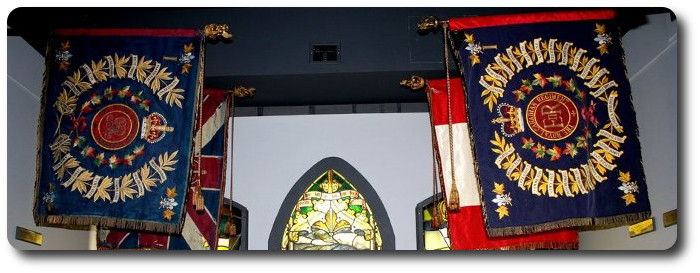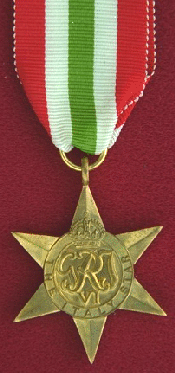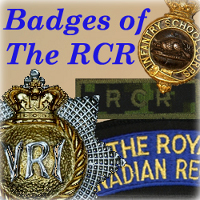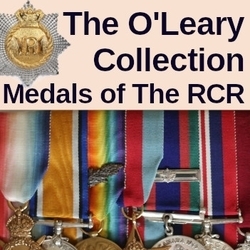
Researching The Royal Canadian Regiment

The Italy Star was awarded for one day operational service in Sicily or Italy between 11 June 1943 and 08 May 1945.
Arielli Front
Major W.W. Mathers
The Connecting File, January 1948
The first indications of winter and new operations came simultaneously to the Regiment at Duronia and the beginning of December saw us once more on the road. In miserable cold and rain, the convoy moved all day and all the next night through the mountain passes and out onto the coastal plain of the Adriatic. At last we joined in the worst traffic tie-up we had ever seen. The whole of the First Division was moving up one side of the only road, the 78th Division was moving down the other side of the same road! in between, where possible, the normal traffic attempted to make its way. Eventually the River Sangro was reached and here we saw the signs of one of the major battles fought up to this time. During the move, some casualties were caused by mines which had not yet been entirely cleared and, on occasion, the battalion came under shell-fire with bombing and strafing from enemy planes. Casualties fortunately were few.
At Fossacesia, a beautiful town on the edge of the Adriatic, surrounded by orange orchards, olive groves and vineyards, there was now nothing but rubble. Here we "staged". Five days from the time we left the Campo Basso Area, we moved through San Vito, across a wide and deep ravine. In the early hours of the evening amidst heavy shelling, we arrived once more in the line.
The coastal plain of the Adriatic is a shelf of flat land extending out from a range of mountains clearly visible at not too great a distance from the sea. Through this plateau a series of mountain torrents have cut deep gorges. Throughout the area in which we were destined now to fight, the plain tops a sheer cliff rising three to four hundred feet above the sea. At least every mile, a great gorge suddenly opens across the plain and, as each of these gorges was met during the Canadian advance, it was found the Germans had blown great demolitions in the four or five hairpin turns the road took to reach the other side. As a result, each ravine literally became a death trap - almost impassable. The whole aspect of the country came to appear, in our minds, almost like a move from one flat mountain top to another.
Below us and to our right lay the Adriatic Sea, a brilliant blue on fine days and a gray blue when it was dull; off to our left rose a tumbled mass of white peaks which forms the Appenine chain of mountains. Northward along the plain itself ran one main road, appearing as it crossed each successive strip of plain and disappearing again successively as it met the gorges. At times, the ground rose slightly and sloped away again on the plateaus. Everywhere the country was covered with groves of gray-green olive orchards. These were interspersed with vineyards looking like cemeteries with their white reinforced concrete posts separating the cross wires from which the grape vines hung. Here and there were dotted large, square, concrete or stucco Casas. These were tinted pink, red, yellow or white and were the houses of the more wealthy farmers. Each farm was surrounded by an orange orchard dark green in colour.
Everywhere there was mud, sleet, snow, mist and rain. Moving across the fields or down the roads, were the inevitable refugees, the women in their thin black dresses and bare feet, with babies in their arms and huge brass kettles or baskets on their heads. They stumbled and slipped through the mud, always in the rear of their men folk, who carried their umbrellas, pushed laden carts and did little else.
Battle on the Moro
The Regiment was once more committed. There were few of us who could anticipate what was to come, although what we had seen on the Sangro should have disillusioned any optimists. It was only later that we came to realize that fighting a retiring German was not the same as tackling one on ground of his own choice which he had been ordered to organize and defend to the last.
The action began with our making contact with the H & PER who with great dash had made a sudden thrust forward on the seacoast and secured a small bridgehead over the Moro River. This they held tenaciously against fierce opposition.
Two nights later the Regiment formed in the bridgehead made by the H & PER and attacked suddenly inland along the Moro to enlarge the bridgehead and seize the village of San Leonardo. This hamlet offered the only spot capable of bridging the river. During this night and the ensuing day, many gallant actions took place. Fighting was very confused, casualties were heavy, communications broke down at times and several very heavy and desperate counter attacks were beaten off. Nevertheless, the Regiment held on relentlessly and "B" Coy. under Major Galloway eventually reached our objective of San Leonardo. This was late in the afternoon of December ninth, although earlier in the day an order had been received for us to fall back across the river. The reason behind Brigade's order was that higher command considered they could not get us the support we required before the Regiment would be completely overrun.
Finally, Lt.-Col. Spry agreed to break off the fight in accordance with his orders. Covered by "A" Coy. under Major Liddell, the battalion withdrew having done great damage to the enemy. To ward off a determined attack in great force by the enemy, "A" Coy. called for artillery fire on its own positions. Under this we were able to clear and reorganize back across the Moro. Great was the praise that came to us for this action. Two days later we returned as part of a larger attack and joined up with "B" Coy. still holding its position in San Leonardo. So the crossing of the Moro took place. For those who took part it will long be remembered for its desperate fighting.
Orange Blossom and Ortona Crossroads
We licked our wounds, reorganized, absorbed reinforcements, buried our dead, patrolled, took prisoners, marched, counter marched and dodged enemy shelling for some days. Then, on the eighteenth of December, with a Squadron of tanks and fourteen regiments of artillery in support, we embarked on Operation Orange Blossom. Orange Blossom, in conjunction with Morning Glory carried out by the 48th Highlanders, was designed to:
(a) Isolate the fort of Ortona (done by Morning Glory) and
(b) Drive a "spike", consisting of the RCR, into the defences of Ortona. (Orange Blossom).
Morning Glory took off first. By passing the defences of Ortona Fort it gained its objective with little incident.
At 1145 hours we went in covered by an incredible barrage with "D" Coy. right, "C" Coy left and Battalion H.Q. close behind. "B" Coy. right and "C" Coy. left moved in reserve.
Alerted by the 48th Highlanders' attack, the enemy parachutist defenders fought desperately but we rolled inexorably on until our artillery support was cut off without reason or warning. The ground gave little cover to the attackers, the enemy "came up" to man his guns and "D" and "C" Coys. were literally slaughtered where they moved. Communications were knocked out and those with our tanks failed. The barrage could not be recommenced. Those tanks which could be rallied were out of petrol. Rather than throw "good money after bad" we consolidated well within the enemy defences with what we had left, preparatory to laying on a new main effort. Casualties were very heavy. The enemy had suffered terribly and the ground surrounding us and to our front was a sea of smoke and flames. Snipers were everywhere. Had our artillery not failed, there is no doubt we should have secured our objectives with minimum loss. Now there was nothing to do but try again.
The pivot on which we consolidated will live in the history of the RCR as "Snipers' Roost" and is marked by the graves of those of our comrades who fell that day.
Here the Regiment remained for a night and a day. Then, led forward personally by Captain Burdett (for which he was awarded the Military Cross) and directed by Lt.-Col. Galloway, the RCR went forward again by night to secure Ortona Cross roads. Thus they opened the way for 2nd Canadian Infantry Brigade to launch their now historic assault upon the heart of the Orton a Fort.
Our part in the battle for Ortona was not yet done. There remained tasks of containing and cutting off the town, while the 2nd Brigade reduced it. Until the beginning of January, 1944, fighting was loose and vicious. Attack was followed swiftly by counter attack. Shelling, bombing, sniping and patroling at close quarters reached a new high in ferocity. Finally, fighting stabilized as the enemy fell back to his new winter line on the Arielli River some miles north of 01'tona. Comparative quiet came at last to this shattered sector of country and we entered on a phase of fighting strange to us but common to our fathers who lived through the first Great War.
Dry Gulching on the Arielli
The term "dry gulching" was used in the early days of our West to denote the art of ambush as it was practised in ravines, gorges, canyons, arroyos - or what have you. It is a term peculiarly applicable to the life we led during the following months.
Shortly after the New Year of 1944, the Regiment took over the San Tommasso-San Nicola area from the Royal West Rents. For six weeks we lived in a salient thrust out ahead of all our fellows. Three Coys. and the Carrier and Mortar Platoons were forward in the salient, bounded on three sides by deep and treacherous gullies. These had cliff-like sides and were lined with scrub and canebrake which crackled loudly when stepped on by patrols at night and burned fiercely when set afire by smoke bombs. On the far side of the gullies the Hun was dug in strongly. Between our Coys. and these three gullies lay two to four hundred yards of open ground - a text book field of fire on both sides - but the Hun was always manning the ravines while we had to face his fire to reach and close with him.
Between the forward Coys. and Battalion H.Q. with the remaining Coy., lay another enormous gully with precipitous sides down which ran the only trail to the forward Coys. This was under constant observation by the enemy from the front and both ends of the gulch. It was under constant heavy fire and many a load of supplies went over the side-many a telephone line went out as Lt. Powers can testify-and many a casualty took his first step towards Canada there. Back on the reverse slope of the next gully behind lay two little stone villages known as San Nicalo (Battalion H.Q.) and San Tommasso ("B" Coy.).
To say that any part of the Battalion Area collected more enemy "hate" than another would be wrong. Nevertheless those of us with the good fortune to have overhead cover were lucky. It was the platoon and section leaders-and above all the riflemen-who were the heroes of this period. Living in mud and water-under incessant heavy fire from every type of weapon—dog-tired—unable to light a fire to cook or even get dry—always on the alert for infiltrating enemy patrols—on patrol themselves night after night—never knowing for sure in the darkness that the chap to whom they whispered in the night was not a Hun; sometimes it was: this was their life.
No praise can be too high for the junior officers of that time. Two enemy parachutist battalions faced the Regiment. Patrolling, infiltration and close quarter fighting was their dish. At these they excelled. The only way to protect ourselves, gain the ascendancy over them and obtain the information our higher commanders needed for our future advance, was to outfight them at their own game. This we did but the years stripped from the deadbeat youngsters who commanded our patrols can never be given back to them; neither can recompense ever be adequate to the wonderful NCO's who gave without fail all they possessed in like manner to the lieutenants.
Never will be forgotten the masses of artillery and mortar fire which crashed down with only yards separating our own from that of the enemy. Never will anyone who was there forget the long hours of waiting by night—the sudden burst of the enemy's "cheesecutters"—our own Brens or Tommys replying—the stealthy noise as our rations, ammunition or water came up—the sudden shriek of a Bosche as tripped on one of our booby traps-the equally sudden blast of machine guns along the whole front when for no reason the evening "fire fight" started up, followed by the crash and crump of artillery and mortars.
We moved out again in the middle of February; this time to what might jokingly be referred to as a "Rest Area" behind San Vito. At least no one was killed by enemy fire. Here in the rain and mud we drilled and trained, absorbed reinforcements, reintegrated, got new clothes and letters from home and best of all achieved some peace of mind. We also provided numberless work parties for the Engineers.
A week later we went back-this time to an area half way between our former area and the coast. At last we got a main headquarters in the luxury of Ortona's shambles. Here we set up a rest centre. As time went on Spring at last began to appear with all the beauty it can show in Italy. Several times we moved back into Brigade Reserve and then forward again either along the coast or just inland. Always there was the shelling and mortaring—always the patrolling by night, the searching for enemy movement by day. It was a life which never seemed as though it would end. Many began to feel they didn't care how soon it would. For many of our best it did and these gallant men we shall always remember. Nevertheless the heart of the Regiment remained stout. All that was needed was the rumor of more active fighting to bring us back on our feet.
This came at last and on a hot and dusty day in April we pulled out of Ortona via Campo Basso and en route to Cassino and the Hitler Line.


